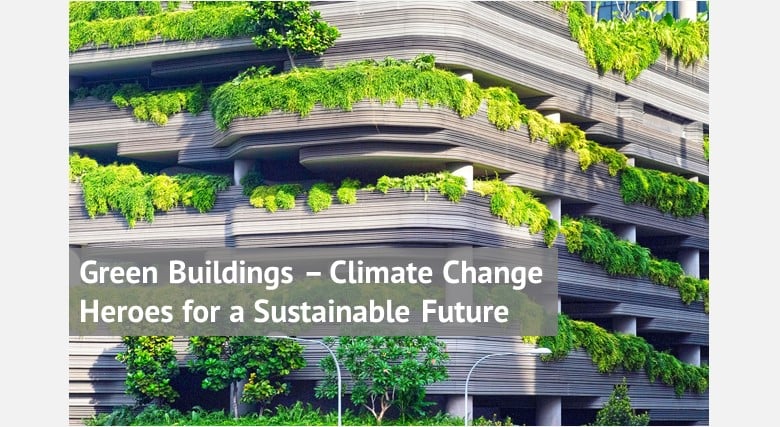With the current state of our climate, rapid change to reduce resource consumption and carbon emissions across all industries has never before been more urgent. Why not start with buildings? Given modern lifestyles, moving about from home to work to cafes, supermarkets and more, people are spending approximately 90% of their time indoors. Addressing buildings not only supports efforts to address climate concerns, it also provides an opportunity to impact the people who inhabit them.
The buildings and construction sector currently contributes nearly 40% of global energy related emissions. While this is a concerning figure, it indicates the sector’s high potential for climate change mitigation by reducing its emissions and increasing its energy savings.
Green Buildings to the Rescue
Business as usual in the building and construction industry is changing, and that change is coming in the form of Green Buildings. Green Buildings are not only good for the planet by reducing resource needs and environmental impact, they are also good for people and profit. They prioritize responsible use of resources and provide healthier indoor space for the building occupants, and because of their effective design and energy and water savings, Green Buildings result in lower operating costs.
By incorporating factors that support increased productivity and overall better health such as improved thermal comfort, air quality, natural lighting, and acoustics, Green Buildings have been shown to result in fewer sick days and reduced absenteeism.
Overall, Green Buildings share a number of the following features:
- Efficient use of energy, water and other resources
- Incorporate the use renewables, such as solar
- Use of sustainable and sustainably sourced materials
- Reduction of pollution and waste
- Provides healthy indoor environment
- Considers the local climate and socio-cultural factors
Highly efficient, sustainable buildings are not just a nice-to-have, they are a must-have and are quickly becoming the standard for design and construction, with many building codes across the globe becoming more stringent to ensure sustainable building practices.
How “Green” is your Building? Using Green Building Rating Tools
Certification offers a level of transparency and verification on the degree of sustainability of a building. It also serves as guidance to the developer and/or owner, offering options and methods to meet Green Building targets.
Rating systems support the building process by outlining standards or specifications required to ensure a project meets a minimum level of performance. There are numerous rating systems and certifications available for implementation, and a comprehensive list is provided on the World Green Building Council website here. The two most common and internationally implemented rating systems are:
1) LEED (Leadership in Energy & Environmental Design), which was developed and is operated by the US Green Building Council, is present in 165 countries. It has 60,000 buildings certified and another 45,000 registered worldwide.
2) BREEAM (Building Research Establishment Environmental Assessment Method), which was the first sustainability assessment method developed for buildings and has been implemented in over 80 countries and has issued over 570,000 certificates.
Less internationally recognized, but just as important, are the numerous local rating systems that have been developed to suit the local context in which they are operated. The Estidama Pearl Rating System in the United Arab Emirates is one example of this, where the system includes sustainability, social, economic and cultural pillars specific to the Arab region. Another example of localized rating systems are those of the Indian Green Building Council, who operates over 20 rating systems that have been developed based on the Pancha Bhootas, the five elements of nature, and are applicable to all climate zones of India.
Ratings and certification systems, the terms often used interchangeably, consider the building as a whole and assesses sustainability aspects of the building design and its construction and operation. They go beyond national regulation and building codes. By establishing both mandatory and elective criteria, their application enforces a minimum set of requirements and encourages applied innovation, efficient building performance, responsible sourcing and disposal of materials. The most common components of Green Building rating systems include:
- Site planning and design
- Indoor Environment
- Materials
- Energy
- Water
- Waste
Rating systems are available for new construction as well as existing buildings with some even focusing specifically on interiors or renovation, making rating systems diverse and applicable to a building of any type and at any stage. While some address single buildings of various types (such as commercial, residential, etc), others extend beyond the individual building to address communities and neighborhoods.
Direct and Indirect Benefits
Benefits of Green Building come for both the building owners and their occupants in the form of:
- Higher market values,
- Reduced running costs,
- Healthier indoor environments, and
- Reduced and more efficient use of resources.
Certified buildings repeatedly demonstrate reduced carbon footprint, reduced utility consumption and reduced waste to landfill. Best results come when all stakeholders of the building and construction process come together during the planning and design stage. With everyone on board and aware of their respective roles in achieving the certification goals, the implementation and certification processes can be smooth and efficient resulting in the optimum outcome.
World Green Building Council has recently launched a case study library of successful projects that have reaped the benefits of implementing Green Building practices, and both LEED and BREEAM also make case studies available highlighting their certified projects. These case study libraries show us that Green Buildings aren’t limited by geography or a country’s economic status, and the concerted efforts that bring them to fruition deliver benefits for people and planet.
What Next after Certification?
Rating systems evolve as new standards and technologies are introduced and they are often updated to ensure the highest levels of sustainability remain targeted. Once certified with a Green Building rating, efforts should not stop there. Buildings should be maintained and operated as designed, to ensure the targeted performance and the saving potential are achieved, and that the building continues to perform at its highest efficiency. Most importantly, building occupants must commit to behavioural changes and habits that support resource efficiency, healthy indoor and outdoor environments, and comfort and wellbeing. Green Buildings provide us with the technology and the tools, but it is the people within them that determine their full potential and effectiveness.
Photo by 贝莉儿 DANIST on Unsplash

